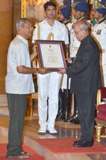 |
 |
 |
http://www.varalaaru.com A Monthly Web Magazine for South Asian History [187 Issues] [1839 Articles] |
 |
 |
 |
http://www.varalaaru.com A Monthly Web Magazine for South Asian History [187 Issues] [1839 Articles] |
|
Issue No. 135

இதழ் 135 [ ஜூலை 2017 ] 
இந்த இதழில்.. In this Issue.. 
|
THE VIMANA The vimana of Ologamathevi Iswaram is a two tier mixed vimana; nagara talas with vesara sikhara. The vimana is sectioned as karna-bhadra-karna divisions and the bhadras are projected, 0.65mts projected on all the four sides. Projected sala on all the four sides is also followed in the Thenkailayam vimana in the same temple complex. The second tala and the sikhara are overhauled and done with modern finishing. The vimana and the mukhamadapa are raised on a upapitha which carries the components of upana, gala and pada flanked by kampa and the peruvajana forms the upper most component. The upana is ornamented with padma series. The upapitha projects according to the projections in the vimana. On the surface of the peruvajana the prime tala of the vimana rests which has an adhishthana, bhitti and prastara. The pratibandha adhishthana has the components of upana, padma jagati, rudra kumuda and the prati series forms the uppermost element. The components are embellished with padma ornamentation; jagati as heavy adhava padma, tiny padma ornamentation on the upper and lower sides of kumuda. The yazhis in the prati series are paired facing each other and the corners are adorned with makara heads, some of the yazhis have proboscis. The makaras are with their jaws wide open and carry sculptures. A warrior with sword emerging out of the mouth of the makara is commonly seen, but here varieties are handled, simha, gana, a combatant mounting the lion, warriors in different action posture are shown. In between the bhitti and the adhishthana is the vedika complex; kantha, pada flanked by kampa and vedika ornamented as padma, forms its components. At some places the kantha and the pada of the vedika complex are decked with miniatures. The bhitti is cantoned by vishnukantha pilasters, each division viz., the karna-bhadra-karna carries two pilasters each. The pilasters possesses pada, the square base, above that raises the vishnukantha shaft which has ornamental elements in the upper region. The capital ornamentations are mala, sthana, kattu, kalasa, tadi, kumbha, pali, phalaka and virakantha. The mala at some places are beaded festoons with flower hangings inside and at some places shown as scrolls with animal miniatures or flowers inside. As like, the sthana is also decorated with leafy scrolls or circle scrolls with miniatures inside. The other capital components are embellished with embossed leafy carvings. The pali is ornamented as padma. The potikas that rest above the pilasters are angular-taranga with kulavu in the angular section and in addition also carry median patta with scroll ornamentation. The potikas that rest above the corner pilasters are four limbed. The potikas bear the uttira and above the uttira are the usual prastara components. The valabhi is decorated with bhuta frieze and the kapota with kudus, corner and median pattas. Kirtimukhas are shown at frequent intervals at the top-edge of the kapota and the scrolls that flow from the mouth of the kirtimukhas form an arch with a kudu in the middle. The kudus are adorned with gandharva heads. Above the kapota is the bhumidesa represented with yazhi frieze. The roof of the newly constructed mandapa surrounding the shrine rests on the main shrine. The hara of the first tala, the second tala and the griva-sikhara are new constructions. The arpita hara of the first tala has karnakuta-bhadra sala-karnakuta elements on each sides connected by the harantara. All the hara elements have alpa nasikas as like the harantara carries single kshudra nasika. The nasikas are plain without sculptures. The harmaya of the second tala is also segmented as karna-bhadra-karna divisions and the divisions are represented with brahmakantha pilasters, while the corners are represented with single pilasters the sala divisions with a pair of pilasters. As like the first tala the sala of the second tala is also projected little. Panjara is shown in between the sala and the karna divisions. Above the bhumidesa of the second tala is the vedika complex on which rests the griva and sikhara. The griva has wall and the prastara components vajana and maddalas. The walls of the griva are adorned with stucco figures of rishis and demigods. The maha nasikas are seen on the cardinal directions. The vesara sikhara is ornamented with geometrical patterns in the body of the sikhara and with bloomed lotus in the bottom and top of the dome. The ridges are decorated with chandra mandalas. A metal kalasa crown the sikhara. The projected salas on the west, north and south are adorned with koshthas whereas on the eastern side the doorway to the sanctum is seen. The koshthas are flanked by rudrakantha split pilasters which carry the same features of the pilasters of the mother wall. Makara thoranas crown the koshthas. Lord Brahma adorns the northern koshtha, Dakshinamurti the southern koshtha whereas the western koshtha is empty. The pranala is shown on the northern side of the vimana below the northern koshtha, in the yazhi frieze. RECESSION In between the mukha mandapa and the vimana is a recession, adorned with a panjara. The recession carries the same features of the vimana first tier viz., adhishthana, bhitti and prastara. The panjara has a pair of rudrakantha pilasters carrying the features of the pilasters of the vimana, but the padma pali is ornamented with sharp edged petals. The potikas at some instances are plain angular and at some instances angular-taranga. Uttira, vajana, valabhi are the prastara elements shown. The panjara is crowned with a makara thorana.
MUKHA MANDAPA The mukha mandapa carries the same features of the vimana prime tala, viz., adhishthana, bhitti and prastara raised above the upapitha. The bhitti of the mukha mandapa is cantoned by four vishnukantha pilasters carrying the same ornamentations of the pilasters of the vimana. The spaces in between the pilasters are adorned with a panjara except the middle pair of pilasters. A koshtha is shown in between the middle pair of pilasters. The koshtha possess the same features of the koshthas of the vimana. Unlike the panjara of the recession, the panjaras of the mandapa walls are adorned with vishnukantha pilasters and also the padma pali is shown with folded edges. Makara thoranas crown both the panjaras and the koshthas. The koshtha in the north is empty whereas the koshtha on the south has remnants of an icon; the presence of Muyalaga at the bottom and the virisadai in the top, the trace of a lifted leg and the ganas with percussion instruments on either side of the koshtha bring to forefront Siva in dancing posture. (To be continued) |

சிறப்பிதழ்கள் Special Issues 

புகைப்படத் தொகுப்பு Photo Gallery 
|
| (C) 2004, varalaaru.com. All articles are copyrighted to respective authors. Unauthorized reproduction of any article, image or audio/video contents published here, without the prior approval of the authors or varalaaru.com are strictly prohibited. | ||